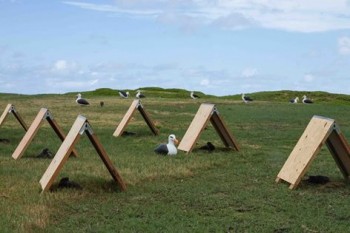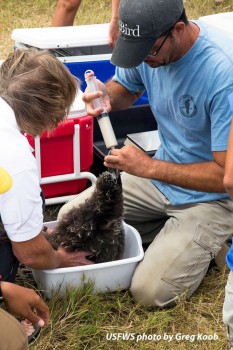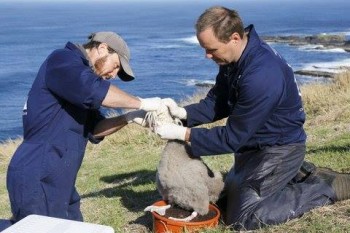In the last two years fertile eggs of the Laysan Albatross Phoebastria immutabilis from the Pacific Missile Range Facility Barking Sands on the Hawaiian island of Kauai have been collected and following artificial incubation and fostering, the ensuing chicks have been hand-reared until fledging at the James Campbell National Wildlife Refuge on the nearby island of Oahu.

Laysan Albatross chicks being hand reared under shade at the James Campbell National Wildlife Refuge, photograph by Lindsay Young
This project is being led by the NGO Pacific Rim Conservation with the twin aims of establishing a new breeding colony that will not be at risk to sea-level rise, as are the species’ major breeding sites on the low-lying North Western Pacific Islands (click here) and reducing the risks of bird strikes at the missile facility (removing eggs should lead to lowered recruitment and eventually to colony shrinkage).
The third year of the translocation project is now underway. A total of 61 eggs was collected from the missile range, of which 47 were deemed to be fertile after candling on site by Pacific Rim Conservation. Fourteen of these eggs were fostered out to Laysan Albatrosses on Kauai, including female-female pairs with infertile eggs (click here).
Most of the remaining 33 eggs are in foster care at Oahu’s Kaena Point Natural Area Reserve, with a few in an artificial incubator until foster nests are found. The chicks will be fed by hand for five months on a purée of fish, squid, Pedialyte (an oral rehydrant) and vitamins (click here).
In the first year of the project the 10 translocated Laysan eggs that hatched in an artificial incubator all successfully fledged; in the second year 19 of the 20 chicks that hatched fledged.

Hand feeding a Laysan Albatross, photograph courtesy of the US Fish & Wildlife Service
In addition, 15 Black-footed Albatross P. nigripes chicks will be transferred from Midway Atoll to the James Campbell NWR in the middle of next month and hand-reared along with their cousins (click here), with the aim of creating a two-species colony.
Meanwhile over in New Zealand plans are breeding made to transfer another batch of Chatham Albatross Thalassarche eremita chicks from their sole breeding locality on the Pyramid to Point Gap in the Chatham Islands in an endeavour to establish a second colony. This will be the fourth year of the translocation project; one more year is planned (click here).

A translocated Chatham Albatross chick gets hand fed at Point Gap, photographs courtesy of the Chatham Island Taiko Trust
John Cooper, ACAP Information Officer, 24 January 2017, updated 27 January 2017

 English
English  Français
Français  Español
Español